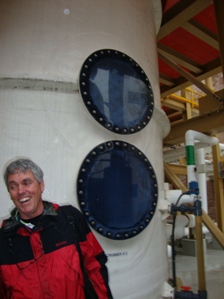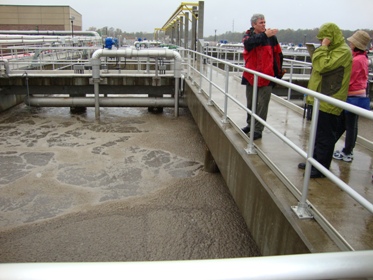A Conference About Water IV: Scum and Sludge
The ESA Millennium Conference took its participants out into the field yesterday in a series of field trips to learn about local water-related issues. This blogger ventured out to the Wayne Hill Water Resources Center in Buford, GA, which processes around 28 million gallons of water per day, although the facility can handle up to 60 million gallons. We learned about the process of purifying water that comes to the plant from homes and businesses, which surprisingly takes each bit of water only about 8 hours to travel through the plant.
The facility uses four stages of purifying: filters, a vortex, microorganisms and micropore membranes to clean and sanitize the water. Not to mention the initial process, which removes the scent from the sewage in respect of the communities nearby the plant. We learned from Paul Barr, an education specialist at the facility, what the difference is between the technical terms “scum” and “sludge”: scum rises to the top of the water (and looks like a root beer float, says Barr), while sludge settles to the bottom.
The trip was a very informative one, even for scholars who study water for a living – it was clear that we academics had much to learn about the nitty gritty (pun intended) process of creating clean and potable water for society. To make the experience even more rich, the remnants of Hurricane Ida were passing through. Standing on the roof of a water treatment plant, staring down into massive drums of water covered with scum while withstanding gale-force winds and rain was quite an experience.

- Paul Barr of the Gwinnett Environmental Heritage Center in front of the machinery that removes the foul stench from waste water.
One interesting caveat was that the plant is attempting to get to the point where they can sell the organic waste skimmed out by the sieving process as mulch and use the methane produced by the bacteria to produce heat used in other parts of processing. Red tape is preventing both of these advances at the moment, but the plant is committed to recycling and reusing as much as possible.
An obvious manifestation of this goal is the plant’s associated Environmental and Heritage Center, an education center about water and the environment that hope to welcome more than 40,000 students through it doors by the end of the year. Completed in 2006, the Gold Certified Leadership in Energy and Environmental Design building has a sloped green roof, a series of rain chains, emphasizes windows to promote natural light and reduce energy use, and even uses reclaimed tombstones as granite for some of the building’s exterior walls. Lord, Aeck and Sargent architect John Starr was there to give us the tour, and he emphasized that the building was meant to educated children about water and inspire them to be future leaders of the environmental movement.
But what really makes the center worthwhile, said education specialist Diane Crossman, is the eight miles of hiking trails that surround the center. Many children just don’t play outside anymore, she said, and inevitably going on a half-hour hike in the woods is most children’s favorite part of their experience at Gwinnett. “At the end of the day I ask them what they liked best about coming to the Center,” she said, “and they always like the hike the best.”
These children are echoing sentiments discussed at this scientific conference: to get people to appreciate their natural resources, they need to experience them.
